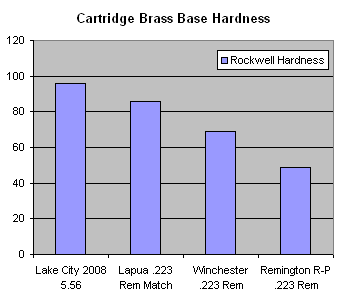Wayne allen
Member
Great, thanks for the very useful info.
 Help Support Long Range Hunting Forum
Help Support Long Range Hunting Forum
What kind of SKILZ does it take to load so hot you stretch out the primer pockets on Lake City 5.56 cases that use the hardest brass of any cartridge case. And then deform the primer pocket with a ball bearing that leaves more of the primer unsupported.

On top of that you can get bulk once fired Lake City cases for .08 cents each with tight primer pockets.
And it doesn't take any SKILZ to get ejector marks on the base of the case and stretched out primer pockets. If you had any reloading SKILZ you would realize your pushing your cases beyond their elastic limits.
Had some free time at work and scraped together some SS plates and a SS Acorn nut.I customized a 1/4" Grade 8 bolt to the diameter that barely passes down the neck of .223 Rem cases. OD of the bolt section that enters the case neck is 0.223"
View attachment 110750
I then processed about 50 Lake City .223 casings, tightening up their loose primer pockets. Success. The Grade 8 bolt didn't bend, and the 0.223" diameter end of the bolt was large enough in diameter that it didn't punch out the small primer pockets towards the case heads. Nice!
View attachment 110751
I doubt that 204 Ruger cases could be salvaged, because taking the bolt OD down to the smaller neck ID size, .200", will not leave enough bolt overlap around the small primer pockets to prevent blowing them out toward the case heads. But the process works well on .223 Rem cases, and should also work on other .224 caliber cases using a small sized rifle primer.
Whatever anybody does, please do not let Forum member 'bigedp51' know of my success. He's prone to temper tantrums when others salvage cases with loose primer pockets, and extend usable case life. And he has a thousand experts from the Snipers Hide forum that he relies on to explain why this feat isn't possible. Big Ed... more SKILZ on display here.
Maybe the slope/ arc angle would dictate the amount vs depth of material moved into the primer pocket. ??
I'll see what l can do.It will make a difference. That's why I purchased 3/4" ball bearings instead of starting out with 5/8". A 1" may be a better choice on large primer pockets. My 3/4" seemed like a happy middle ground choice on these small primer pockets, but a 1" diameter ball bearing used on the large primer pockets would flare less deeply into the primer pocket, in my professional engineer's opinion.
I've got a 10 pack of 3/4" ball bearings. Will trade some out to anyone that purchases a pack of 1" ball bearings. Hah!
2 - 5/8" bearings for a single 1" bearing...
The Acorn nut is a NoGo!I must have annealed the **** out of it while welding.
Back to the bearing.